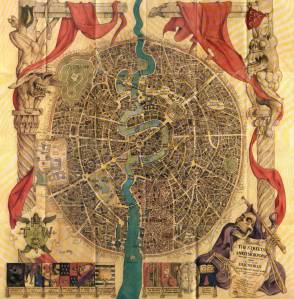Two weeks ago I went to the preview show of the Craft Council’s 12 Tall Tales exhibit, which uses the work of twelve artists to tell stories through the objects they made. The point of the exhibition, however, wasn’t to tell stories by depicting them, but through rather more abstract means. There’s a lot of great stuff at the exhibit and I’d encourage you to go if you can, but I wanted to share a few of my favourites.

The guide to the exhibit – I don’t agree with some of their labelling though!
Fortune Telling
The exhibit was a row of metal cylinders with spinning dials of light dots at the top. The idea was that, in this Age of Information, predicting anything is just a matter of data analysis. Want to know when you’re going to get a heart attack? Analyse your diet, fitness regime, personal and family health records, etc., and the machine can give you an answer. All it takes is access to the data.
It made me think of Arthur C Clarke’s quote about suitably advanced technology being indistinguishable from magic. Imagine a crystal ball with a USB socket. Plug in the data, ask the question, and the fortune teller will give you an answer. It’s not magic, it’s science. And, the way technology’s going, it’s not even science fiction.
Contaminated Craft
Four black earthenware bowls for storing food, made roughly and unpolished. Nothing special to look at. But the clay was taken from a Japanese rice farm in the Fukushima Daiichi nuclear power plant exclusion zone, and is mildly radioactive. The bowls are
…as purposeless as the land is to the farmers of Fukushima… The vessels express a narrative that goes far beyond their form of function, acting as material witnesses to the nuclear disaster. ~ Exhibit sign
That’s a hell of a story, for a dish.
Just A Hint
This was a bit more abstract. There were ceramic casts of various bits of household objects, like an AC vent, or an Xbox.
In the same way that the chisel or loom is no longer visible in a piece of furniture or tapestry, the principle tool of creation – the story – is suggested but no more. ~ Exhibit sign
You’re sort of bringing archeology into art, here. The existence of the object is proof of the existence of the history and the next trick is to work out what that history was. Looking around your room right now, then, pick up to six objects. What story do they hint at?
Can You Handle Another Story?
This exhibit was sadly not operational, as we were at a preview, but the idea was compelling. There were a number of objects, mostly ancient archeological finds, a flat brass square with faint lines on it, and an audio guide. You listened to the audio guide which began telling you about the objects and ended by weaving them together as characters in a new story.
There’s a number of ways this could be done. All the objects could become anthropomorphic; they could become crucial to a plot, a la Chekov’s Gun; their individual stories could become interlinked throughout history; or, and this is the one that I find most intriguing, it could be that bringing the objects together is a catalyst that sets off a series of events. Two cursed objects, whose curses combine, for example. Or a faulty gas lamp starts a fire which burns down a building, which reveals a forgotten painting with a secret message encoded into it, which… you get the point. But the idea of telling a story without really needing living characters to push the plot along is an intriguing one. Anyone know of any examples?
Roll A D12
And finally… the way the exhibits were displayed involved a D12 (or 12-sided die) on the exhibit, and matching that number to the explanations on the wall. You could also use the diagram below to roll a D12 and design your own object:

My object is an absurd necklace made of gold that represents life in fifty years. Now, I can write a story for that but I’m rubbish at designing objects. So, suggestions on a postcard please!
Alternatively, go roll your own… 😉


 a work-out for writers. Not the physical kind, thankfully. Physical exercise and me, well, we’re acquainted but our relationship is strained at best. No, this was a mental workout. The gym leader – personal trainer? – set a series of exercises, each with an individual prompt, and a time limit within which to write a scene that fit those requirements.
a work-out for writers. Not the physical kind, thankfully. Physical exercise and me, well, we’re acquainted but our relationship is strained at best. No, this was a mental workout. The gym leader – personal trainer? – set a series of exercises, each with an individual prompt, and a time limit within which to write a scene that fit those requirements.

